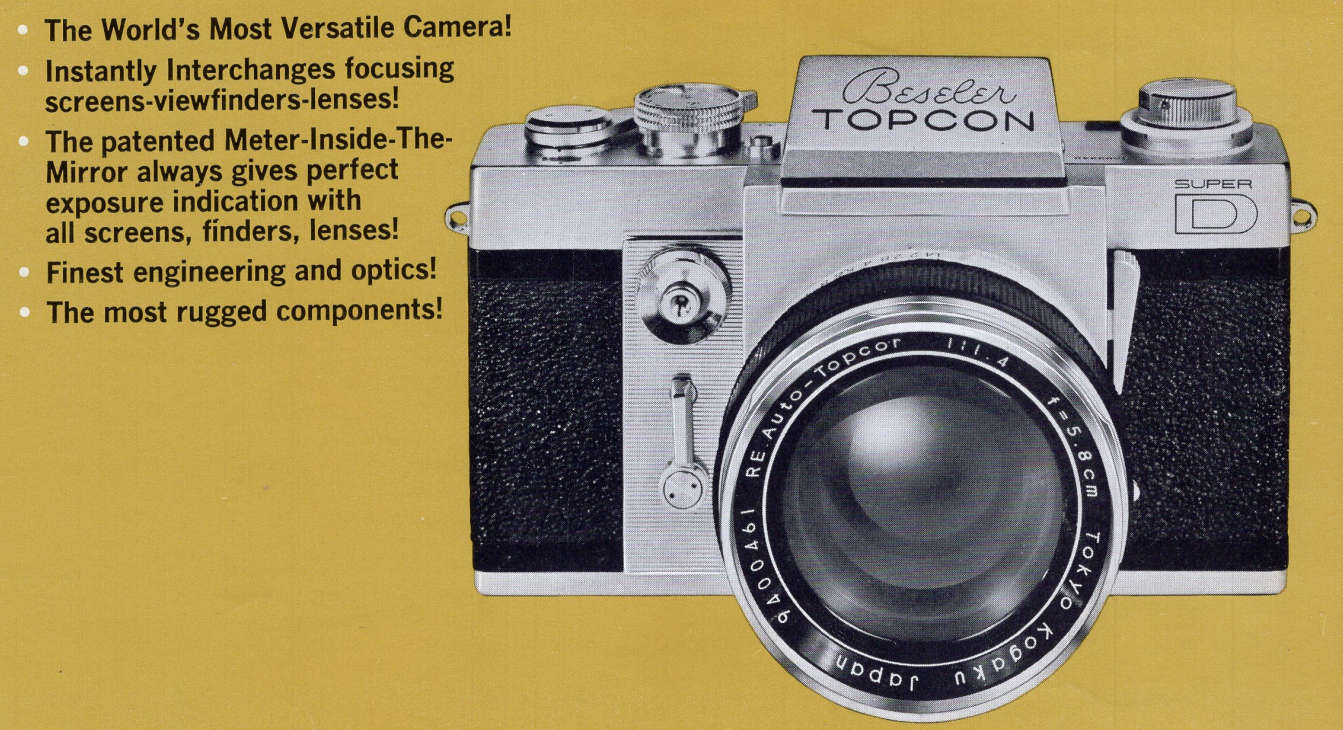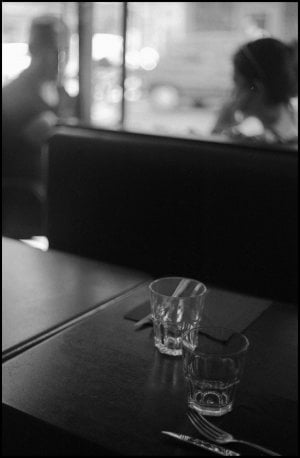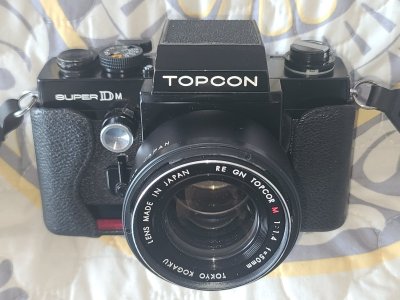Tim Murphy
Well-known
Dear Board,
I have an older Topcon RE Super with the 58mm f1.4 that used to work just fine but now no longer works. The mirror hangs up, the meter is now dead, and I decided the camera wasn't worth fixing.
To that end I purchased a Topcon Super DM and was wondering about the interchangeability of various parts like the focusing screens and the rewind knob flash mount shoe. I have several focusing screens and a functional bellows that I received years ago when I bought the RE Super. I'm hoping the new camera shares compatibility with all those items.
Lastly, and please excuse my ignorance about this, but when I see Exakta/Topcon mount used to describe lenses many of the lenses have the old Exakta shutter release button affixed to the lens. What happens when you mount one of these old lenses on a newer Topcon body?
Regards,
Tim Murphy
Harrisburg PA
I have an older Topcon RE Super with the 58mm f1.4 that used to work just fine but now no longer works. The mirror hangs up, the meter is now dead, and I decided the camera wasn't worth fixing.
To that end I purchased a Topcon Super DM and was wondering about the interchangeability of various parts like the focusing screens and the rewind knob flash mount shoe. I have several focusing screens and a functional bellows that I received years ago when I bought the RE Super. I'm hoping the new camera shares compatibility with all those items.
Lastly, and please excuse my ignorance about this, but when I see Exakta/Topcon mount used to describe lenses many of the lenses have the old Exakta shutter release button affixed to the lens. What happens when you mount one of these old lenses on a newer Topcon body?
Regards,
Tim Murphy
Harrisburg PA
Trask
Established
I have an RE Super, so that's where I'm starting from. Check out these links for info comparing the RE Super, Super D and Super DM, you may find some info that addresses your first question:

I've often done exactly what you suggest -- mount an Exakta mount lens on my Topcon. I use a Schneider-Kreuznach Xenon F/1.9 which has the outboard aperture stopdown/shutter release button: press it in a bit and the lens stops down, press it further (if mounted on an Exakta) and the plunger hits the shutter release button built into the Exakta and the shutter is released. In my case, the lens mounts properly but of course the Topcon doesn't have a body shutter release in the "correct" location, so the plunger strikes the front of the camera lens box, but thankfully there's enough clearance that the aperture will stop down all the way to f/22 before that happens.
So doing this requires that you focus, select the desired f/stop, then press the "shutter release" plunger on the lens to stop down the lens, then press the shutter release on the camera itself -- forget that third step and your shot will be overexposed (unless you intended to shoot wide open). Things can get interesting -- on my Xenon, the lens plunger can be set so that the aperture closed down when you press the plunger, or it can be set to close down even as you set the f/stop. So, if you're using the internal meter of the Super D, you could select your desire shutter speed, compose, focus, then close down the aperture to the point where the meter indicates proper exposure. The image in the viewfinder will darken, of course, but as you've already focused that won't be that much of a problem as long as the screen isn't so dark that you can't frame the shot.
The little plunger that hits the camera body could conceivably mark your camera, but a small piece of tape will reduce that concern -- as long as the tape isn't so thick that it prevents the lens from being fully closed down at minimum aperture.
Here's a photo made with the RE Super/Schneider Xenon combo.


Topcon RE Super/Super D
topcon re super, topcon super d, topcor lens, topcon re-2, topcon
www.678vintagecameras.ca
I've often done exactly what you suggest -- mount an Exakta mount lens on my Topcon. I use a Schneider-Kreuznach Xenon F/1.9 which has the outboard aperture stopdown/shutter release button: press it in a bit and the lens stops down, press it further (if mounted on an Exakta) and the plunger hits the shutter release button built into the Exakta and the shutter is released. In my case, the lens mounts properly but of course the Topcon doesn't have a body shutter release in the "correct" location, so the plunger strikes the front of the camera lens box, but thankfully there's enough clearance that the aperture will stop down all the way to f/22 before that happens.
So doing this requires that you focus, select the desired f/stop, then press the "shutter release" plunger on the lens to stop down the lens, then press the shutter release on the camera itself -- forget that third step and your shot will be overexposed (unless you intended to shoot wide open). Things can get interesting -- on my Xenon, the lens plunger can be set so that the aperture closed down when you press the plunger, or it can be set to close down even as you set the f/stop. So, if you're using the internal meter of the Super D, you could select your desire shutter speed, compose, focus, then close down the aperture to the point where the meter indicates proper exposure. The image in the viewfinder will darken, of course, but as you've already focused that won't be that much of a problem as long as the screen isn't so dark that you can't frame the shot.
The little plunger that hits the camera body could conceivably mark your camera, but a small piece of tape will reduce that concern -- as long as the tape isn't so thick that it prevents the lens from being fully closed down at minimum aperture.
Here's a photo made with the RE Super/Schneider Xenon combo.

Tim Murphy
Well-known
Dear Trask,
Thank you for your post and a very interesting article to read.
Regards,
Tim Murphy
Harrisburg PA
Thank you for your post and a very interesting article to read.
Regards,
Tim Murphy
Harrisburg PA
The entire Topcon D series are interchangeable, Topcon lenses, screens, finders, motors, film backs.
Exakta 35mm lenses will generally mount on Topcon D's, but you may find a few exceptions to that rule.
Stephen
Exakta 35mm lenses will generally mount on Topcon D's, but you may find a few exceptions to that rule.
Stephen
Eastwestphoto
Member
72A Topcon Super Dm is a far cry from a 46A re Super model.
1. The build quality of materials were changed to reduce cost of 1973-75 recession , inflation period. Making a profit was a big concern as Topcons foray in UV mount cameras was a giant mistake. ( leaf shutter SLR,s)
2. Updated 46-A design was changed to become more competitive against Nikon, Pentax, Minolta, Canon.
A. 180 deg. Winding lever was changed to 135 deg, by using bearings and shims stacked. Specialized lubrication was used, which 50+ years later turns to glue
B. Mirror box changed to accommodate Mirror up lever.
C. Shutter lock installed, unfortunately known too break
D. Exposure counter linked to shutter winder has troubles resetting to 0.
E. Mirror etching changed too better balance foreground and sky, also portrait use.
F. Cam follower, mc 50/1.4 GN lens designed FOR INCREASED resolution wide open. Known to be frozen as a rock due too bad lubrication ( green goop) of dissimilar metals.
G. Light meter case and mechcanism build not as good as 46A , lots of broken meters.
H. Prism redesigned to allow f:stops visible. A good change.
I. Made only in black, strikingly handsome camera and lenses.
J. Red LED contact added to Dm/ motorwinder, a good design.
Since the 73 recession caught the camera world off guard in planning, and a deep recession followed, Japanese government ordered 15% decrease in production. Camera Sales in world dropped. Topcon needed those increased sales of its new model Dm. That didn't happen at all. Price was more expensive than Nikon, and Beseler insisted on fair trade rules. Fewer Dm models were sold, by 75-76 Topconwas leaving the world of high quality professional SLR cameras.
Today; little choice, the Dm model needs a complete over haul. Parts are very scarce, repairs take a long time, knowledge has been lost. Despite all, serviced; a Topcon Dm is one hell of a solid well made camera for film shooting and the optics are amazing performers on digital mirrorless cameras.
1. The build quality of materials were changed to reduce cost of 1973-75 recession , inflation period. Making a profit was a big concern as Topcons foray in UV mount cameras was a giant mistake. ( leaf shutter SLR,s)
2. Updated 46-A design was changed to become more competitive against Nikon, Pentax, Minolta, Canon.
A. 180 deg. Winding lever was changed to 135 deg, by using bearings and shims stacked. Specialized lubrication was used, which 50+ years later turns to glue
B. Mirror box changed to accommodate Mirror up lever.
C. Shutter lock installed, unfortunately known too break
D. Exposure counter linked to shutter winder has troubles resetting to 0.
E. Mirror etching changed too better balance foreground and sky, also portrait use.
F. Cam follower, mc 50/1.4 GN lens designed FOR INCREASED resolution wide open. Known to be frozen as a rock due too bad lubrication ( green goop) of dissimilar metals.
G. Light meter case and mechcanism build not as good as 46A , lots of broken meters.
H. Prism redesigned to allow f:stops visible. A good change.
I. Made only in black, strikingly handsome camera and lenses.
J. Red LED contact added to Dm/ motorwinder, a good design.
Since the 73 recession caught the camera world off guard in planning, and a deep recession followed, Japanese government ordered 15% decrease in production. Camera Sales in world dropped. Topcon needed those increased sales of its new model Dm. That didn't happen at all. Price was more expensive than Nikon, and Beseler insisted on fair trade rules. Fewer Dm models were sold, by 75-76 Topconwas leaving the world of high quality professional SLR cameras.
Today; little choice, the Dm model needs a complete over haul. Parts are very scarce, repairs take a long time, knowledge has been lost. Despite all, serviced; a Topcon Dm is one hell of a solid well made camera for film shooting and the optics are amazing performers on digital mirrorless cameras.
Attachments
DownUnder
Nikon Nomad
Sad that Herbert Keppler is no longer around to respond to this thread.
I recall - from reading his magazine articles many, many years ago - that he was exceedingly fond of this camera.
Oddly, it never seemed to go far beyond the boundaries of the USA. I recall a few on secondhand photo gear shelves in Canada in the late '60s-early '70s, but I've never seen one in Australia, tho' I did once spot a Topcor 50/1.8 lens at a photo fair. Whether it came from a camera brought to Oz or it migrated here on its own, we will never know.
Not a great contribution to this thread, rather a sort of aside. Tim, I hope you will be able to achieve all you want to do by shifting and swapping parts between the two bodies. The fun is in the trying.
I recall - from reading his magazine articles many, many years ago - that he was exceedingly fond of this camera.
Oddly, it never seemed to go far beyond the boundaries of the USA. I recall a few on secondhand photo gear shelves in Canada in the late '60s-early '70s, but I've never seen one in Australia, tho' I did once spot a Topcor 50/1.8 lens at a photo fair. Whether it came from a camera brought to Oz or it migrated here on its own, we will never know.
Not a great contribution to this thread, rather a sort of aside. Tim, I hope you will be able to achieve all you want to do by shifting and swapping parts between the two bodies. The fun is in the trying.
Share:


